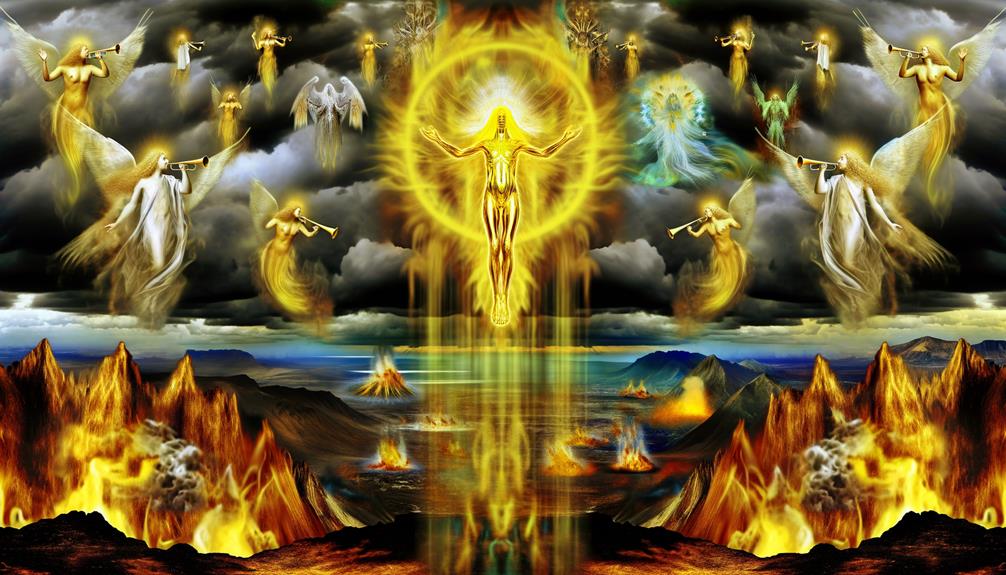End of Time Meaning in the Bible: Final Judgment
The Bible’s concept of the ‘end of time‘ integrates prophetic insights from the Old and New Scriptures, forming a thorough eschatological narrative. Old Testament books like Daniel and Isaiah use symbolic imagery to depict divine judgment and ultimate deliverance, while the Book of Revelation in the New Testament provides an apocalyptic vision of final judgment and the restoration of God’s kingdom.
Jesus’ teachings emphasize vigilance and preparedness for this unknown hour, promising both judgment and redemption. These texts collectively embody a theological framework that explores divine sovereignty and the fulfillment of God’s plan, offering profound insights for further reflection.

End of Time Meaning in the Bible: Prophetic Significance and Eternal Destiny
| Aspect | Biblical Interpretation | Key Verses |
|---|---|---|
| Definition | The final culmination of earthly history and time | Revelation 10:6 |
| Second Coming | Christ’s return marks the end of time and beginning of eternity | Matthew 24:30–31 |
| Final Judgment | Time ends with God judging all people | Revelation 20:11–15 |
| Resurrection and Eternity | Signals resurrection of the dead and eternal destinies | John 5:28–29, Daniel 12:2 |
| Spiritual Insight | Urges repentance, vigilance, and hope in God’s eternal plan | 2 Peter 3:10–14, Romans 13:11 |
Old Testament Prophecies

The Old Covenant prophecies concerning the end of time are pivotal in understanding the eschatological framework within which the ancient Hebrew scriptures were written.
These prophecies, found in books such as Daniel, Isaiah, and Ezekiel, offer profound insights into the anticipated culmination of history.
The prophetic literature often employs vivid imagery and symbolic language, depicting events like the Day of the Lord and the coming Messianic age.
These texts not only reflect the theological aspirations of the ancient Israelites but also serve to convey divine promises and judgments.
New Testament Revelations

In examining the New Testament Revelations, John’s apocalyptic vision in the Book of Revelation stands as a cornerstone, rich with symbolic imagery.
The revelation of the Seven Seals provides a structured narrative that elucidates the divine plan for humanity’s ultimate destiny.
This culminates in a vivid portrayal of the Final Judgment, where theological themes of justice and redemption are profoundly articulated.
Symbolism in John’s Vision
Drawing from the vivid and often enigmatic imagery in the Book of Revelation, John’s vision employs intricate symbolism to convey profound theological truths about the end times.
The use of symbols such as the four horsemen, the beast, and the New Jerusalem serves to illustrate the ultimate triumph of good over evil.
The four horsemen, representing conquest, war, famine, and death, depict the manifold trials humanity will face.
The beast symbolizes the forces of opposition to divine sovereignty, while the New Jerusalem epitomizes the ultimate establishment of God’s kingdom.
Through these symbols, John communicates complex eschatological themes, urging believers to remain steadfast in faith amidst tribulation, while offering hope in the promise of divine redemption and renewal.
Seven Seals Unveiled
John’s vision of the Seven Seals in the Book of Revelation further expands on the eschatological narrative, revealing a series of divine judgments that underscore the unfolding of God’s ultimate plan for humanity. Each seal, when broken, initiates a specific event that brings the world closer to its prophesied end. These events are profoundly symbolic, offering insights into the divine justice and cosmic order.
- First Seal: The appearance of the conqueror on a white horse, symbolizing conquest and victory.
- Second Seal: The red horse, representing war and bloodshed.
- Third Seal: The black horse, indicative of famine and economic distress.
These seals collectively articulate the divine orchestration of apocalyptic events.
Final Judgment Described
The New Covenant’s depiction of the Final Judgment meticulously illustrates a pivotal moment where divine justice is executed and the moral order is ultimately reaffirmed.
Revelation 20:11-15 vividly portrays this eschatological event, where the dead, great and small, stand before the throne. Books are opened, including the Book of Life, determining each soul’s eternal fate based on their deeds.
The imagery of the lake of fire represents the finality of divine judgment and the eradication of evil. Theologically, this scene underscores the inexorable righteousness and omniscience of God, affirming His ultimate authority.
Contextually, it serves to reassure believers of the eventual triumph of good over evil, providing a profound hope for divine rectitude at the culmination of history.
Book of Daniel

The Book of Daniel offers profound insights into eschatological themes through its prophetic visions, particularly the Seventy Weeks prophecy, which many theologians interpret as a timeline for messianic and end-time events.
These visions are rich in symbolism, providing a complex tapestry of imagery that has been subject to extensive theological analysis.
Understanding Daniel’s prophecies is essential for comprehending the broader biblical narrative concerning the end times.
Prophetic Visions Unveiled
Daniel’s prophetic visions in the Bible offer a profound theological exploration of the eschatological timeline, revealing critical insights into the end of time. His visions encompass a spectrum of divine revelations that have been the subject of extensive theological analysis.
Key elements of Daniel’s visions include:
- Four Beasts: Symbolizing successive empires, representing the unfolding of historical epochs.
- Ancient of Days: A majestic depiction of God’s eternal sovereignty and judgment.
- Son of Man: A figure granted dominion and glory, foreshadowing messianic expectations.
These visions collectively provide a vivid portrayal of divine intervention and the ultimate fulfillment of God’s plan.
Seventy Weeks Prophecy
Among the prophetic visions revealed, the Seventy Weeks prophecy stands out for its intricate portrayal of the divine chronology leading to the Messiah and the end of time.
Found in Daniel 9:24-27, this prophecy delineates a period of ‘seventy weeks’ or ‘seventy sevens,’ traditionally interpreted as 490 years.
The prophetic timeline is divided into distinct segments, each symbolizing pivotal events in redemptive history. The initial seven weeks cover the rebuilding of Jerusalem, the subsequent sixty-two weeks lead to the advent of the Messiah, and the final week foretells tribulations culminating in ultimate deliverance.
Theologically, this prophecy underscores God’s sovereign orchestration of history, emphasizing themes of judgment, restoration, and the eventual establishment of His eternal kingdom.
End Times Symbolism
Frequently regarded as a cornerstone of apocalyptic literature, the Book of Daniel employs rich symbolism to depict the eschatological events preceding the end of time.
Through intricate visions and allegories, Daniel presents a profound theological framework for understanding divine sovereignty and cosmic conflict.
Key symbols include:
- Four Beasts: Representing successive empires, highlighting the temporal nature of human kingdoms.
- The Ram and the Goat: Symbolizing the Medo-Persian and Greek empires, respectively, underscoring the transitory nature of worldly power.
- Seventy Weeks: A prophetic timeline pointing to pivotal eschatological events.
This symbolic language invites deep reflection on divine providence, human history, and the ultimate triumph of God’s kingdom.
Book of Revelation

The Book of Revelation, often regarded as the most enigmatic and apocalyptic text in the Bible, provides a vivid and symbolic portrayal of the end times. It offers insights into divine judgment, the ultimate triumph of good over evil, and the fulfillment of God’s eternal plan.
Composed by the Apostle John, Revelation is rich with theological themes and prophetic visions that have been subject to extensive analysis and interpretation. Contextually, it addresses the early Christian communities facing persecution, providing both warning and hope.
Theologically, it emphasizes God’s sovereignty, the coming of Christ, and the establishment of a new heaven and new earth. Understanding Revelation requires a nuanced approach, considering its historical context, literary form, and eschatological significance.
Apocalyptic Imagery

Apocalyptic imagery in the Book of Revelation serves as a profound theological tool, employing vivid and often symbolic visions to convey the ultimate realities of divine judgment and cosmic renewal.
This imagery encapsulates the dramatic end-time events that highlight God’s sovereignty and the final eradication of evil. Such imagery can be understood contextually within the broader biblical narrative, revealing deep theological truths.
- The Four Horsemen: Symbolize conquest, war, famine, and death, representing widespread calamities.
- The Beast and the Dragon: Represent forces of evil and opposition to God’s kingdom.
- New Jerusalem: Symbolizes the ultimate hope of a renewed creation and divine presence.
These elements collectively underscore the eschatological themes central to Revelation.
Prophetic Symbols

Prophetic symbols in the Bible serve as rich, multifaceted metaphors that convey divine messages and future events through vivid and sometimes enigmatic imagery.
These symbols are embedded within apocalyptic literature, such as Daniel and Revelation, and often include beasts, horns, and celestial phenomena.
Contextually, these symbols draw from historical and cultural references familiar to the original audience, enhancing their theological significance. For instance, the ‘beast’ can signify oppressive empires, while ‘horns’ denote power and authority.
These symbols require careful exegesis to understand their layered meanings and prophetic fulfillments.
Interpreting prophetic symbols necessitates a deep engagement with the biblical text and an appreciation for its historical context, ensuring a nuanced comprehension of God’s revealed plan for the end times.
Jesus’ Teachings

Focusing on Jesus’ eschatological teachings reveals a profound narrative that intertwines imminent judgment with the promise of redemption, providing an all-encompassing framework for understanding the end times from a Christian theological perspective.
Central to Jesus’ discourse are the themes of vigilance and preparedness, urging believers to remain spiritually alert. He emphasizes the unpredictability of the final hour, underscoring the necessity of readiness.
- Parables of Watchfulness: Jesus employs parables like the Ten Virgins to illustrate the need for vigilance.
- Second Coming: He promises His return, highlighting both judgment and salvation.
- Signs and Warnings: Jesus provides signs that will precede the end times, encouraging discernment.
This teaching underscores a dual focus: caution and hope.
Interpretations Over Time

Throughout history, interpretations of Jesus’ eschatological teachings have evolved, reflecting diverse theological, cultural, and historical contexts.
Early Christian communities, under Roman persecution, viewed Jesus’ promises of an imminent end as a source of hope and resilience.
Medieval theologians, influenced by Augustinian thought, often allegorized eschatology, seeing the ‘end times’ as symbolic of the Church’s spiritual journey.
The Reformation, with its emphasis on scriptural authority, prompted renewed literal interpretations, often associating apocalyptic imagery with contemporary events.
In modern times, eschatological interpretations range from dispensationalist views, which predict distinct chronological end-time events, to existentialist perspectives, focusing on individual transformation.
Consequently, the understanding of Jesus’ teachings on the end of time remains dynamic, shaped by ongoing theological reflection and historical circumstance.
Theological Perspectives

Theological perspectives on the end of time in the Bible reveal a complex interplay between doctrinal interpretations and scriptural exegesis. Scholars and theologians approach eschatology with diverse lenses, each influenced by historical, cultural, and denominational contexts.
Key theological viewpoints include:
- Premillennialism: Belief in Christ’s second coming before a literal thousand-year reign.
- Amillennialism: View that the millennium is symbolic, representing Christ’s reign through the Church.
- Postmillennialism: Expectation of a golden age of Christian dominance before Christ’s return.
These perspectives shape believers’ understanding of biblical prophecy, influencing ecclesial teaching and personal faith practices. The dialogue between these viewpoints continues to enrich theological discourse.
Conclusion
In summation, the biblical concept of the end of time weaves a tapestry of prophetic visions, theological debates, and apocalyptic imagery.
From Daniel’s cryptic visions to Revelation’s vivid depictions, these texts have spurred centuries of interpretation.
Jesus’ teachings further enrich understanding while theological perspectives offer varied insights.
Consequently, the end of time in the Bible emerges not merely as a conclusion but as a multifaceted narrative inviting continuous exploration and reflection within the domains of faith and scholarship.






